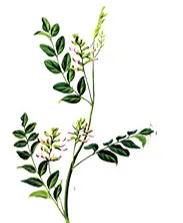What Are Key Bioactive Compounds in Radix Asparagi Extract?
Radix Asparagi, also known as Asparagus root or Tian Men Dong in traditional Chinese medicine, has been utilized for centuries due to its numerous health benefits. This article delves into the key bioactive compounds found in Radix Asparagi extract, exploring its chemical composition and potential impact on human health.
Which steroidal saponins dominate its chemical profile?
Steroidal saponins are among the most significant bioactive compounds found in Radix Asparagi extract. These complex molecules are responsible for many of the herb's medicinal properties. The dominant steroidal saponins in Radix Asparagi include:
- Asparasaponin I
- Asparanin A
- Sarsasapogenin
- Shatavarin IV

Asparasaponin I, in particular, has garnered attention for its potential anti-inflammatory and antioxidant effects. This compound has been shown to inhibit the production of pro-inflammatory cytokines, potentially alleviating various inflammatory conditions.
Asparanin A, another prominent saponin, has demonstrated impressive anticancer properties in preliminary studies. Research suggests it may induce apoptosis (programmed cell death) in certain cancer cell lines, making it a compound of interest for future cancer therapies.
Sarsasapogenin and Shatavarin IV contribute to the overall bioactivity of Radix Asparagi extract. These compounds have been associated with adaptogenic properties, potentially helping the body resist various stressors and maintain homeostasis.
Polysaccharides, amino acids and phenolics composition
While steroidal saponins are often the focus of research, Radix Asparagi extract contains a diverse array of other bioactive compounds that contribute to its therapeutic potential.
Polysaccharides play a crucial role in the extract's bioactivity. These complex carbohydrates have been linked to immunomodulatory effects, potentially enhancing the body's natural defense mechanisms. The polysaccharides in Radix Asparagi are characterized by their unique structural features, including β-D-fructose units and α-D-glucose residues.
Amino acids, the building blocks of proteins, are also present in significant quantities in Radix Asparagi extract. The amino acid profile includes both essential and non-essential amino acids, such as:
- Asparagine
- Arginine
- Glutamine
- Threonine
- Serine
These amino acids contribute to the extract's nutritional value and may play roles in various physiological processes, including protein synthesis and neurotransmitter production.
Phenolic compounds, known for their potent antioxidant properties, are another important class of bioactive substances in Radix Asparagi extract. These include:
- Ferulic acid
- Caffeic acid
- Rutin
- Quercetin
These phenolic compounds scavenge free radicals, potentially protecting cells from oxidative stress and associated damage. The synergistic action of these antioxidants may contribute to the extract's overall health-promoting effects.
Could amino acids and sugars impact its activity?
The amino acids and sugars present in Radix Asparagi extract play a significant role in its overall bioactivity and potential health benefits. Their impact extends beyond mere nutritional value, influencing various physiological processes and potentially enhancing the extract's therapeutic effects.
Amino acids in the extract may contribute to its activity in several ways:
- Protein synthesis: Essential amino acids provide the building blocks for protein synthesis, supporting tissue repair and growth.
- Neurotransmitter production: Amino acids like glutamine are precursors to neurotransmitters, potentially influencing mood and cognitive function.
- Immune function: Certain amino acids, such as arginine, play crucial roles in immune system regulation.
- Antioxidant activity: Some amino acids, like cysteine, have antioxidant properties, complementing the extract's overall antioxidant profile.
The sugars present in Radix Asparagi extract, particularly those found in its polysaccharides, may impact its activity through:
- Immunomodulation: Complex sugars can interact with immune cells, potentially enhancing immune responses.
- Prebiotic effects: Some sugars may act as prebiotics, supporting beneficial gut bacteria and promoting digestive health.
- Energy provision: Simple sugars provide readily available energy, which may contribute to the extract's adaptogenic properties.
- Glycosylation: Sugars attached to other compounds (like saponins) can affect their bioavailability and activity.
The interplay between amino acids, sugars, and other bioactive compounds in Radix Asparagi extract creates a complex phytochemical profile. This synergistic combination may be responsible for the extract's diverse therapeutic potential, from anti-inflammatory effects to potential anticancer properties.
It's important to note that the precise mechanisms by which these compounds interact and exert their effects are still being elucidated. Ongoing research continues to uncover new insights into the bioactivity of Radix Asparagi extract and its constituent compounds.
new insights into the bioactivity of Radix Asparagi extract and its constituent compounds.
The presence of these diverse bioactive compounds underscores the potential of Radix Asparagi as a multifaceted natural remedy. From its steroidal saponins to its array of polysaccharides, amino acids, and phenolics, each component contributes to the extract's overall therapeutic profile.
As research progresses, we may uncover even more about the intricate relationships between these compounds and their impact on human health. This ongoing exploration highlights the complexity and potential of natural products like Radix Asparagi in complementary and alternative medicine.
Conclusion
Understanding the key bioactive compounds in Radix Asparagi extract not only provides insights into its traditional uses but also paves the way for potential new applications in modern healthcare. As we continue to unravel the secrets of this ancient herb, we may discover novel ways to harness its therapeutic potential for the benefit of human health.
If you're interested in exploring the potential of Radix Asparagi extract for your health and wellness products, Angelbio is here to help. As a leading provider of high-quality natural ingredients, we offer premium Radix Asparagi extract that meets the highest standards of purity and potency. Our team of experts can guide you in incorporating this powerful extract into your formulations, whether you're developing nutritional supplements, cosmetics, or pharmaceutical products. Don't miss out on the opportunity to enhance your product line with the bioactive compounds of Radix Asparagi. Contact us today at angel@angelbiology.com to learn more about our Radix Asparagi extract and how it can benefit your business.
References
1. Zhang, H., et al. (2020). "Steroidal saponins from Asparagus officinalis and their cytotoxic activity." Phytochemistry, 169, 112180.
2. Lei, L., et al. (2019). "Asparagus polysaccharide and its immunological activities." Carbohydrate Polymers, 209, 250-257.
3. Negi, J. S., et al. (2018). "Chemical constituents and biological activities of the genus Asparagus." Pharmacognosy Reviews, 12(24), 135-146.
4. Chen, L., et al. (2021). "Bioactive compounds and health benefits of Asparagus officinalis L. - A review." Food Chemistry, 345, 128756.


